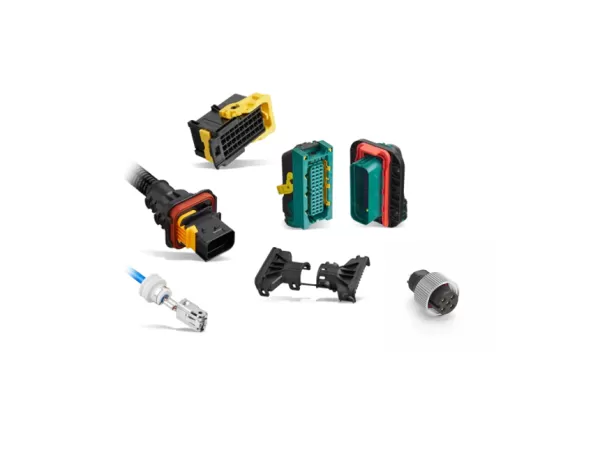What are the automotive connector solutions?

Automotive connectors are an important part of automotive electrical systems, responsible for connecting various electrical devices and control systems to ensure the transmission of signals and power. With the continuous development of automotive electronic systems, the demand for connectors is also growing. The following are some common automotive connector solutions:
1. Traditional wiring harness connector
Traditional wiring harness connectors are widely used in the internal electrical system of automobiles to connect different electronic devices such as sensors, control modules, lighting systems, etc. They usually include plastic housings, terminals and sealing rings, and are durable, waterproof and corrosion-resistant.
- Advantages : mature, stable, relatively low cost
- Disadvantages : Too many wiring harnesses can easily lead to a complex system and increased weight
2. Modular connectors
Modular connectors are a highly flexible connection system that allows different modules to be freely combined according to needs. Such connectors are usually used to transmit multiple signals and power, such as CAN bus, LIN bus, etc.
- Advantages : High flexibility, easy to upgrade and maintain
- Disadvantages : complex design and high cost
3. High voltage connector
With the development of new energy vehicles (such as electric vehicles and hybrid vehicles), high-voltage connectors have become an indispensable part. Such connectors can withstand higher voltages and currents and are used to connect high-voltage components such as batteries, inverters, and motors.
- Advantages : High pressure and high temperature resistance, ensuring high efficiency and safety
- Disadvantages : higher price, requires more stringent design and manufacturing process
4. Coaxial connector
Coaxial connectors are mainly used to transmit high-speed data signals, especially in advanced driver assistance systems (ADAS) and in-vehicle entertainment systems. Coaxial cables and connectors can effectively prevent signal interference and ensure the reliability of high-speed data transmission.
- Advantages : high bandwidth, low interference, suitable for high-speed data transmission
- Disadvantages : High cost, cables and connectors require precise installation
5. Fiber Optic Connectors
Fiber optic connector solutions are used in situations where ultra-high-speed, long-distance data transmission is required, such as LiDAR systems and vehicle-to-everything (V2X) communications in autonomous driving technology. Fiber optics can effectively eliminate electromagnetic interference (EMI).
- Advantages : high speed, long distance, anti-electromagnetic interference
- Disadvantages : complex installation and maintenance, expensive
6. Passive wireless connection
In recent years, wireless connection technology has also been gradually applied to the automotive industry, reducing the use of traditional wiring harnesses and is often used for short-distance data transmission, such as tire pressure monitoring systems (TPMS) and wireless charging systems.
- Advantages : No physical cable connection required, simplified design, reduced weight
- Disadvantages : limited data transmission speed and stability, limited applicable scenarios
7. Waterproof connector
In order to meet the requirements of using cars in harsh environments (such as rain, dust, etc.), waterproof connectors adopt a sealed design and are usually used for electrical connections in external environments such as engine compartments and chassis.
- Advantages : waterproof, dustproof, corrosion-resistant
- Disadvantages : Slightly higher cost, need to pay attention to the aging of seals
8. High-speed data connector
High-speed data connectors are used to connect in-car entertainment systems, navigation systems, cameras, and radar systems to ensure high-speed and stable data transmission in the vehicle network. Such connectors usually support interfaces such as USB, HDMI, and Ethernet.
- Advantages : Supports high bandwidth, suitable for in-car infotainment systems
- Disadvantages : High precision is required during installation, and the system complexity increases
9. Automotive Ethernet Connector
With the popularization of connected vehicles and autonomous driving technology, the demand for automotive Ethernet connectors is growing rapidly. Such connectors support high-speed data transmission in the car and are used for communication between cameras, radars, and control modules.
- Advantages : Support high bandwidth and low latency
- Disadvantages : High cost in the new technology promotion stage
10. Smart Connectors
Smart connectors integrate diagnostic functions to monitor data such as connection status and signal quality, so that problems can be discovered and resolved in a timely manner. These connectors are mainly used in high-end automobiles and autonomous driving systems.
- Advantages : Improved reliability and simplified troubleshooting
- Disadvantages : complex technology and high cost
Summarize
Different types of automotive connector solutions meet the increasingly complex electrical system requirements of the automotive industry. From traditional wiring harness connectors to high-speed data transmission and high-voltage power connections, automotive connector technology is developing towards a more intelligent and efficient direction.
Are you interested in a specific automotive connector solution?